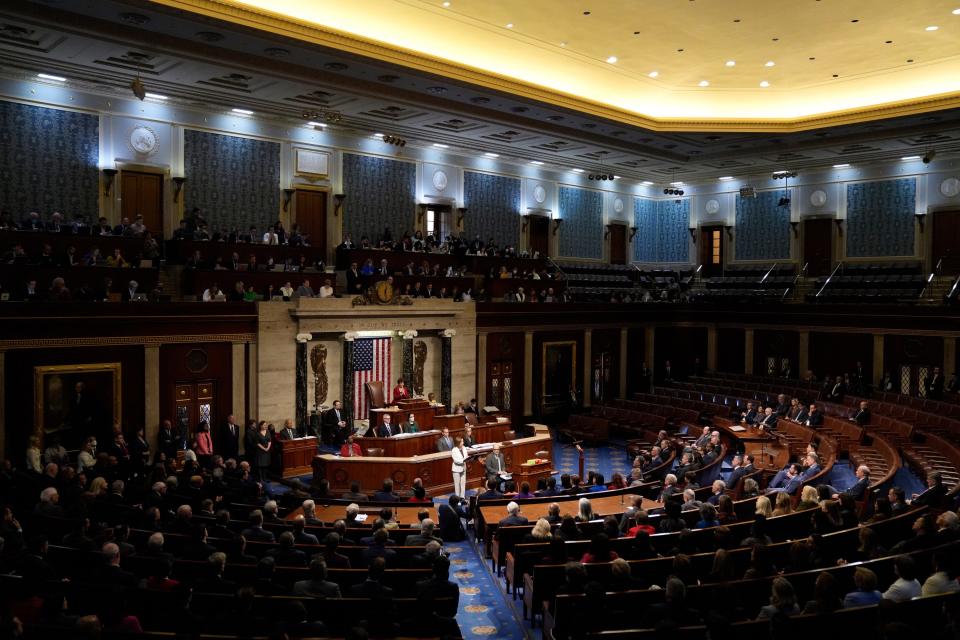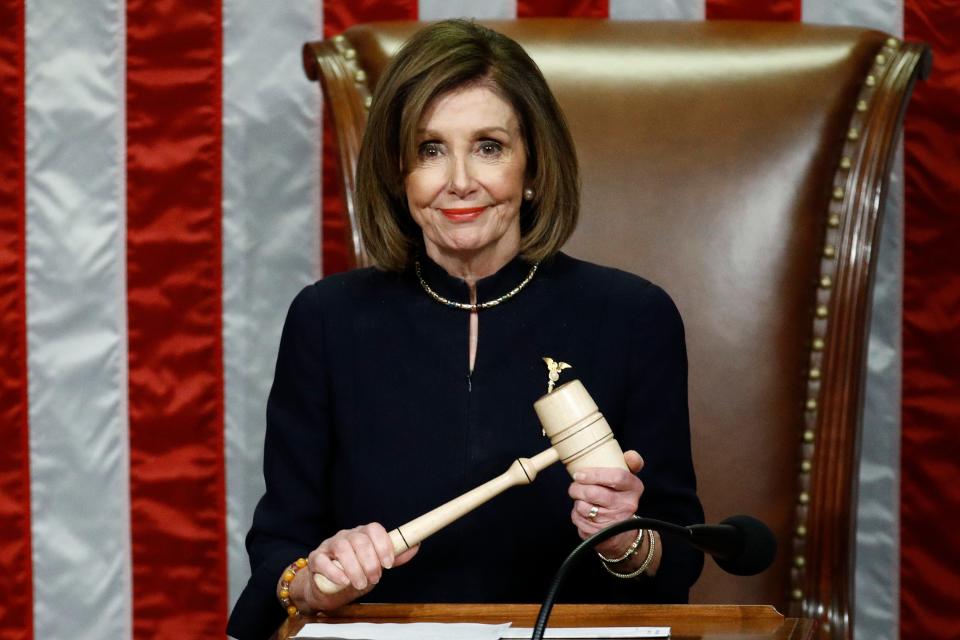What happens after McCarthy loses multiple speaker votes? Here's how the process works.
- Oops!Something went wrong.Please try again later.
The first day of the 118th Congress ended Tuesday without a new House speaker. Voting resumed Wednesday – and still no speaker.
House Republican leader Kevin McCarthy failed to secure enough votes to become speaker of the House on six ballotsover both days, heightening tumult around the new GOP majority. For the first time in a century, the House was unable to pick a speaker on the first vote.
The speaker is the most powerful role in Congress, in line behind the vice president to succeed the president should the commander in chief be incapacitated. But the more immediate and prominent authority the speaker wields is controlling the agenda and committee assignments that shape legislation in the lower chamber of Congress.
When Republicans took the majority in November's midterm elections, McCarthy became the top contender for the speakership after GOP lawmakers elected to keep him last month as head of the caucus. But a faction of the party balked at giving him the support he would need to secure the position.
Rep. Andy Biggs, R-Ariz., challenged McCarthy for the powerful leadership role and earned 10 votes on the first ballot Tuesday. By Wednesday, Biggs appeared to be out of the running for the gavel as did Ohio Rep. Jim Jordan, who received 20 votes on the third ballot. Florida GOP Rep. Byron Donalds became the McCarthy alternative, earning 20 votes on the fourth, fifth and sixth ballots.
In contrast, every one of the 212 elected Democrats voted for Rep. Hakeem Jeffries, leader of the House Democrats, in all six rounds.
McCarthy allies — who outnumber the “never Kevin” bloc — have said they aren’t budging in supporting “only Kevin.”
Stay in the conversation on politics: Sign up for the OnPolitics newsletter
More: Kevin McCarthy’s race for speaker risks upending the House of Representatives
The speaker of the House is the only political position in the House elected by all its members. Here's how the election works and what could happen if McCarthy does not reach the vote threshold needed for the speakership.
How does the speaker vote process begin?
Prior the start of a new Congress, both parties hold a private meeting where they elect the party leadership for the next Congress. This takes place before Jan. 3, the official start of the new term when all House members vote for the speaker.
A candidate only needs a majority of votes from their respective party to win the endorsement in the private meeting for leadership.
Even if a colleague votes against a candidate in the private caucus meeting, the party typically sticks together to back their nominee on the House floor in January, according to Matt Glassman, a senior fellow at Georgetown University's Government Affairs Institute.

More: A poor GOP showing in the midterms could hamper Kevin McCarthy's path to be House speaker
However, when the whole House votes, anyone can be nominated. And just a few votes in opposition to a candidate from their own party could cost them the speakership if the majority is narrow as is the case with the Republicans: as few as five GOP House members could block the party leader from winning the gavel.
"Which creates a scenario where people could dissent, a very small faction could stop you from winning on the floor in your own party," Glassman said.
How is the speaker vote held?

The clerk of the House from the prior Congress gavels in the opening session and presides as speaker until one is elected.
The clerk first calls for a quorum to establish that enough members are present to conduct business and then proceeds immediately to the speaker election – before the swearing in of newly elected members.
The clerk calls lawmakers in alphabetical order by last name who then announce their choice for speaker by calling out the last name of the candidate. This differs from the usual electronic voting conducted in the House on legislation.
Candidates for speaker are nominated from the floor by members of their parties. There is always one Democratic nominee and one Republican, but the speaker does not have to be a member of the majority party or even a member of Congress.
How many votes are needed to be chosen as Speaker?

The magic number is 218 – kind of.
A candidate requires votes from a majority of lawmakers who are voting to be elected speaker. That means if all 435 members are present and voting, the number of votes needed is 218.
But lawmakers can decide to skip the vote, or vote "present," which reduces the vote threshold needed to win the speakership. Speakers Nancy Pelosi, D-Calif., and John Boehner, R-Ohio, both won the speakership without reaching 218 votes.
More: Kevin McCarthy wants to block three Democrats from committees if he becomes House speaker
In the new Congress, all 434 members (one fewer than 435 because Virginia Rep. Donald McEachin recently died and a successor has yet to be chosen) can vote. If the results, for example, are: 216 votes for McCarthy, 212 for a Democratic candidate and 6 representatives vote for someone else, the 216 votes would not be the majority of 434 needed for the speakership. McCarthy would come up short.
However, if those six representatives do not vote for someone else, they don't count toward the total votes needed. This lowers the threshold to 428, meaning a 216 vote could secure the speakership for McCarthy.
Glassman said this is often used as a tactic by speaker candidates who convince their colleagues to, in essence, abstain as a compromise between voting for another candidate and supporting their candidacy.
"That's certainly a viable strategy," he said.
What happens if a candidate doesn't get the majority of votes?

If the first ballot fails to provide a speaker, lawmakers will continue to vote until a candidate receives a majority. Members can vote for different candidates each ballot.
It's not common that there is more than one ballot, but it has happened.
In 1923, it took multiple ballots – nine – to elect a speaker. On three occasions prior to the Civil War, a speaker was not elected on the first ballot. In one instance, it took 133 ballots over a period of two months.
As a last resort, lawmakers can adopt a resolution that would elect a speaker by a plurality or by rank-choice voting instead of a simple majority.
Glassman said McCarthy needs at least 213 votes because the 212 House Democrats are likely going to all back their party leader, Rep. Hakeem Jeffries of New York. Of the remaining nine GOP lawmakers who have expressed reservations about supporting McCarthy, the California Republican will need some combination of votes for him, "present" vote or no votes.
"The important thing functionally is nothing else happens in the House until they have a speaker," Glassman said, adding that the House won't be able to adopt rules, assign committees or consider legislation until the speaker is chosen.
How do members typically vote?

Lawmakers traditionally vote for their party's nominee, but some in recent years have chosen to vote "present" or not vote.
"This is sort of a modern thing in the last 10 years," Glassman said. "We've had members of the majority party threatening not to vote for their party's nominee on the floor."
He cites one reason as the current media environment where outliers realize they can gain attention from opposing a speaker nominee and separate themselves from the leadership to appeal to voters.
"It's a way to stand out," he said.
The last to vote for the opposite political party was Democratic Rep. Jim Traficant from Ohio. He voted in 2001 for the Republican speaker nominee and faced severe consequences: Democrats stripped him of his committee assignments.
How will this play out for McCarthy?

A two-month speakership election is not likely.
McCarthy won the closed-door vote leadership election, and by wide margins, after facing challenger Biggs, the Republican of Arizona and a member of the ultra-conservative Freedom Caucus.
The votes on Tuesday and Wednesday, which included all members of the House and not just the Republican party, have yet to put McCarthy – or anyone else – over the vote threshold to win the speakership.
The speaker vote could play out in a few ways.
Members will continue to vote for days, weeks or months until a speaker candidate receives enough votes, which means no other legislative business will be conducted and members will not be officially sworn in.
One option for McCarthy is to continue to try to bargain with his colleagues to gain enough votes, though that hasn't worked so far. He could also drop out of the race for speaker, leaving an opening for another Republican to win the gavel.
Despite the repeated ballots, no McCarthy challengers have come close to gaining the majority of votes for the gavel.
"If none of those things happen, then you're in for a real chaos situation because then you have to try to find candidates somewhere in the party who weren't even on the radar screen," Glassman said.
This article originally appeared on USA TODAY: How the House picks a speaker: What happens after McCarthy loses?

